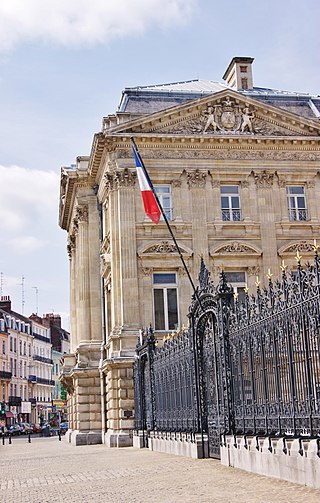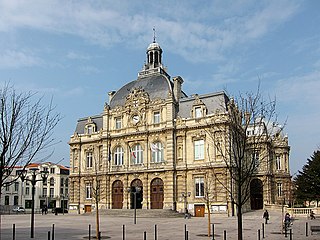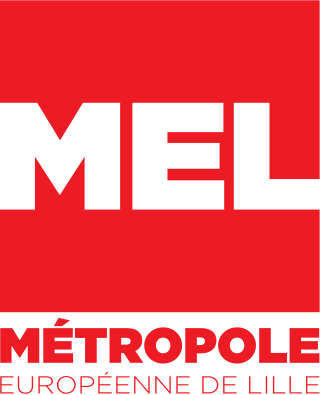
Nord is a département in Hauts-de-France region, France bordering Belgium. It was created from the western halves of the historical counties of Flanders and Hainaut, and the Bishopric of Cambrai. The modern coat of arms was inherited from the County of Flanders.

Lille is a city in the northern part of France, within French Flanders. Positioned along the Deûle river, near France's border with Belgium, it is the capital of the Hauts-de-France region, the prefecture of the Nord department, and the main city of the European Metropolis of Lille.

Roubaix is a city in northern France, located in the Lille metropolitan area on the Belgian border. It is a historically mono-industrial commune in the Nord department, which grew rapidly in the 19th century from its textile industries, with most of the same characteristic features as those of English and American boom towns. This former new town has faced many challenges linked to deindustrialisation such as urban decay, with their related economic and social implications, since its major industries fell into decline by the middle of the 1970s. Located to the northeast of Lille, adjacent to Tourcoing, Roubaix is the chef-lieu of two cantons and the third largest city in the French region of Hauts-de-France ranked by population with nearly 99,000 inhabitants.

Tourcoing is a city in northern France on the Belgian border. It is designated municipally as a commune within the department of Nord. Located to the north-northeast of Lille, adjacent to Roubaix, Tourcoing is the chef-lieu of two cantons and the fourth largest city in the French region of Hauts-de-France ranked by population with about 97,000 inhabitants.

The Métropole Européenne de Lille is the métropole, an intercommunal structure, composed by a network of big cities whose major city is the city of Lille. It is located in the Nord department, in the Hauts-de-France region, northern France – bordering both the Flemish and Walloon regions of Belgium. It was created in January 2015, replacing the previous Communauté urbaine de Lille, and covers that part of the Lille metropolitan area that lies in France. Its area is 671.9 km2. Its population was 1,179,050 in 2019, of which 234,475 in Lille proper. The annual budget of the métropole is €1,865 billion (2018).

The arrondissement of Lille is an arrondissement of France in the Nord department in the Hauts-de-France region. It has 124 communes. Its population is 1,237,472 (2016), and its area is 879.5 km2 (339.6 sq mi).

Edgar Boutry (1857–1938) was a French sculptor who executed several public statues and monuments and worked on several Monuments aux Morts. He also ran the Écoles académiques lilloises.
The following is a timeline of the history of the city of Marseille, France.
The following is a timeline of the history of the city of Lille, France.

Rémy Cogghe, originally spelled Rémi Coghe was a Belgian-born painter, residing in France.
The following is a timeline of the history of the city of Nice, France.
The following is a timeline of the history of the city of Toulon, France.
The following is a timeline of the history of the city of Amiens, France.
The following is a timeline of the history of the city of Nîmes, France.
The following is a timeline of the history of the city of Clermont-Ferrand, France.
The following is a timeline of the history of the city of Poitiers, France.
The following is a timeline of the history of the city of Mulhouse, France.
Mahjoub Ben Bella was an Algerian-born French painter and designer. He is well known for his murals and cobblestone designs for Paris–Roubaix.

The Departmental Council of Nord is the deliberative assembly of the French department of the Nord, the most populous French department. The headquarters of this decentralized local authority are in Lille.

The Hôtel de Ville is a historic building in Tourcoing, Nord, northern France, standing on the Rue Paul Doumer. It was designated a monument historique by the French government in 1981.









